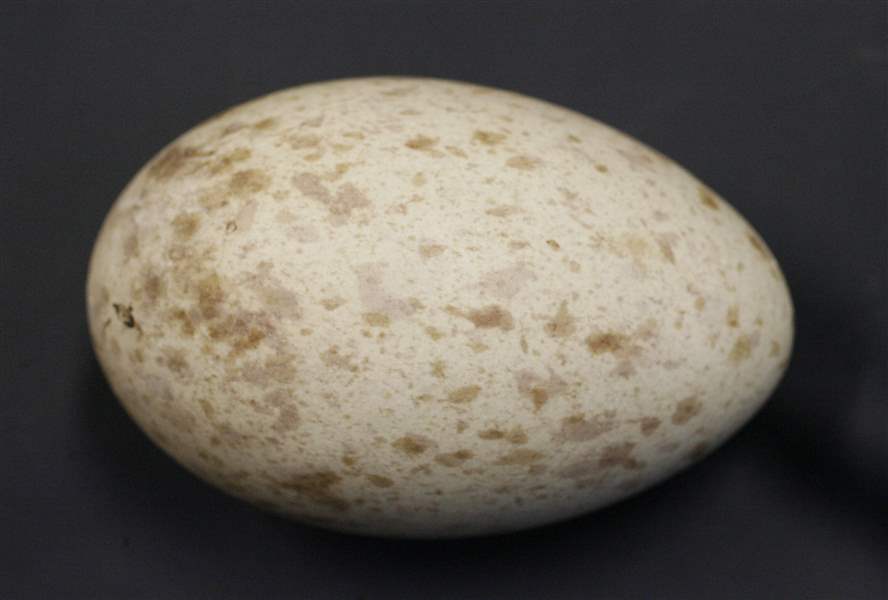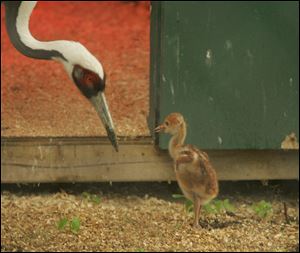
White-naped crane chick something to crow about
5/11/2009
White-naped cranes lay mottled eggs the length of two golf balls. The eggs are distinctively oval and quite smooth.
Jetta Fraser

The Toledo Zoo's white-naped crane mother, Anita, watches her chick that hatched April 27. The baby's arrival was a first for the zoo. The species is considered vulnerable.
He, or possibly she, looks like a cinnamon-colored puffball with claw feet.
Fluffy with downy feathers, the new white-naped crane sticks close to its mother, Anita, as the father, Ivan, guards their home, a green shed on the grounds of the Toledo Zoo where the curator of birds is crowing about the arrival.
The chick came out of its shell April 27 in the zoo's first hatching of this species.
Not only is it the hatching the zoo's first, it also was from the first fertilized egg that either Anita or Ivan has produced, making the new arrival particularly notable, curator Robert Webster said.

White-naped cranes lay mottled eggs the length of two golf balls. The eggs are distinctively oval and quite smooth.
Anita, hatched three years ago at the National Zoo's off-site Conservation and Research Center in Front Royal, Va., and Ivan, hatched in 2002 at the Memphis Zoo, have lived at the Toledo Zoo since November, 2007.
On a recent rainy afternoon, Ivan strolled over to the fence to greet zoo visitors eager to peek at the baby with the beak.
But visitors shouldn't be fooled by Ivan's welcoming approach. If they cross over onto his turf or get too close to his offspring, it's no more Mr. Nice Guy.
White-naped cranes tend to be fiercely protective of their young, and this explains why it took three people to hold down the daddy during the chick's checkup last week (the chick came through with flying colors).
When you have "a crane with child, you want to control the beak," Mr. Webster said.
The four-foot-tall cranes defend themselves and protect their chicks with their long, sharp beaks.
Too tiny yet to step up into the green shed, the chick extended its neck when the mother offered food from just inside the doorway.
Anita often goes inside the house for bits of crumble - a man-made, nutritious concoction - to share with her baby.
Shaking off droplets of rain, the chick gingerly explored the tall grass, stopping to poke at sunshine-bright dandelions. At one point, the chick showed off. Stretching its few inches into several, it strutted, flashing stubby wings in "look at me" fashion.
The family resides in an area between the waterfowl and penguin exhibits.
Visitors can watch the trio from a nearby bridge ramp, and they can hear Ivan's loud squawks of warning: Don't get too close, or else.
Although it entered a tech-savvy world, the chick neither tweets nor twitters.
It peeps and cheeps. The baby, Mr. Webster said, is saying, "I'm a part of this family, too."
Anita and Ivan took turns keeping their palm-sized, brown-speckled egg warm during a month-long incubation period.
"They are very good incubators," Mr. Webster said. "One sits on the egg and the other patrols."
The nest was outdoors in their yard, an area with a plentiful supply of earthworms and grubs ripe for picking by pecking beaks.
"The parents are tilling the soil pretty good," Mr. Webster said.
Mom and dad share parental duties, but Anita tackles about 75 percent of the work, such as showing the little one how to hunt for food, Mr. Webster said.
Ivan's specialty is guard duty. "He's on alert for anything," he said.
Ivan the Aggressor does display his softer side to Anita and their new baby, and the parents are acting like love birds as they bond.
Cranes often dance together, bowing, jumping, tossing sticks and grass.
The male throws back his head and trumpets and bugles, Mr. Webster said.
At one time, the Toledo Zoo had another pair of white-naped cranes, but they were beyond reproductive years. "They were in their 40s," Mr. Webster said. Cranes can live into their 60s or 70s, he said.
The chick will stay here at least a year. What happens after that depends on a species survival plan developed with the Association of Zoos and Aquariums.
To help ensure a healthy and genetically diverse zoo population throughout the country, the Toledo Zoo participates in the program..
Sixty white-naped cranes live at 22 zoos accredited by the association, and in the last year only two other crane chicks have hatched.
As wetlands continue to disappear in its native Asia, the crane is listed as "vulnerable" on the World Conservation Union's Red List of Threatened Species.
The Toledo Zoo, which houses 160 species of birds, will test feathers to determine the chick's gender and then a name will be selected.
The zoo should know in a few weeks if the chick is male of female, but either way, it's all good, Mr. Webster said.
The chick, and the parents, are "happy, healthy, and wise," he said, and that's what matters.
Contact Janet Romaker at:
jromaker@theblade.com or
419-724-6006.